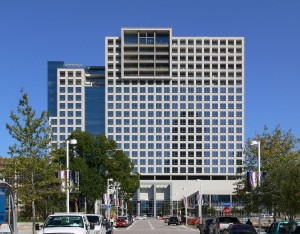At this location, you can ask your participants to imagine that they were working on construction for this building, and that the panes of glass in the main grid of windows on this face of the building needed to be ordered. How many panes would you need to order? In the discussion, bring out the fact that there are terraces on the upper levels, so they don’t need that same pane of glass; restrict your count to just the panes that are right on the surface of the building, amidst (the two sections of) the concrete grid.
Some problem-solving strategies that may come up: divide the count into the two sections of the concrete grid. In the right-hand section, the glass panes form a perfect rectangle, so you can count them by multiplying 17 windows across horizontally by 11 windows high to get 187 panes of glass. We will have to add this to the result from the other section of the building. That one is not a rectangle, so we could either divide it into a 4-by-7 rectangle (on the bottom) plus a 3-by-4 rectangle (on the top), or visualize it as a 4-by-11 rectangle with the four top-left panes missing. Either way you work, you will get 40 panes in this section, for a total of 227 panes in all. This exercise provides a good opportunity to illustrate how there can be more than one way to attack a problem, and each different way can give further insight into the nature of the problem.
You can also discuss, time permitting, whether having made the count, you would order exactly 227 panes. Presumably not, because it would be too risky; absolutely nothing could go wrong with any of the panes. Since glass can be fragile, you would likely order some extra. Depending on budgets, you might order as much as 10% extra. How many would that be? Well, 10% of 227 rounds to 23, and adding that to 227 gives a nice round 250 panes of glass as a conservative order. (Note that you will likely be spending money on glass that you will never use, but that’s the price of avoiding the risk of ending up short a pane of glass in case of breakage.)
There’s one other interesting story about this building. In a first draft math tour, the tour leader Glen Whitney asked what was the shape the window panels counted in the challenge above. “Well, they look like squares.” And then he asked what the shape of the large structure projecting out from the building near the top was. “That looks like a square, too.” Glen then stated that they couldn’t both be squares. Why? Well, if you count window units across, the big structure is clearly six units across. And counting window units up the side of the big structure, it appears to be five units high. If one rectangle is five-by-six in terms of another rectangle, they clearly can’t both be squares; one or the other might be, or neither, but they can’t both be. However, one of the tour participants quietly pointed out to Glen later in the tour, “If you look at the building from far away, I think you will see that the big structure extends past the top of the building and both it and the windows are squares.” Judging from the picture below, I believe that’s absolutely correct. The structure does extend past the top of the building, so that it appears to be exactly six units high, so that it and the individual windows are squares. 
I didn’t include this story here with any intention that it would be mentioned on a typical tour. Instead, I think it holds several important lessons for the tour process as a whole. (1) You will make mistakes. Acknowledge that. Try your absolute best to minimize those mistakes as close to zero as possible, but realize that no matter how hard you try, you will make a mistake now and then. So don’t present yourself as an infallible authority. (2) Math tours, like all mathematical experiences, are works in progress; they can always be refined, extended, polished, improved, corrected, or expanded. (3) The folks that come along on the tours are a valuable resource. Engage them. Listen to them. And most important of all, be open to learning from them. If you are, you certainly will, and these interactions will enrich your experience as a tour leader and make leading math tours more rewarding.


